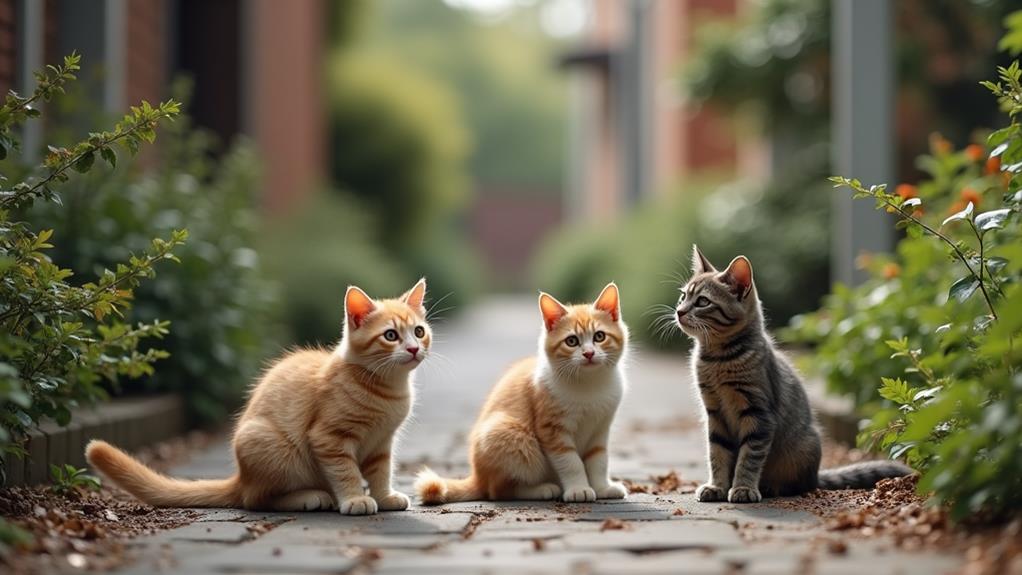How to Tell if a Cat Is Feral or Stray: What's the Difference?

To distinguish between a feral and stray cat, observe their behavior and appearance. Stray cats, once pets, are friendly and approachable, often vocal, and have a clean appearance. They might approach you for food or shelter. Feral cats, however, avoid human interaction, appear wary, and may hiss when threatened. They are typically unkempt and live by their instincts. Notice physical signs like ear-tipping, which indicates a feral cat from a TNR program. Stray cats are generally easier to socialize back into homes. Understanding these differences helps in deciding how best to help them, potentially allowing for further insights.
Understanding Stray Cats
Understanding stray cats requires recognizing their unique characteristics and behaviors. Unlike feral cats, stray cats are former pets that have been socialized to humans. This means they're accustomed to human contact and often actively seek interaction. When you encounter a stray, you might notice signs of friendliness, such as vocalization or approachability. These behaviors indicate their previous experiences with people, setting them apart from their more elusive feral counterparts.
Stray cats typically maintain a clean and well-groomed appearance, suggesting they've received regular care in the past. This is a significant indicator that they can often be rehabilitated and reintroduced to indoor life. However, successful reintroduction requires an adjustment period. During this time, your patience and proper care are essential as the stray gets accustomed to living indoors again.
It's vital to act promptly when you spot a stray cat. Without timely intervention, stray cats may revert to more feral behaviors, especially if they experience long-term deprivation of human contact. By understanding these unique characteristics, you can better distinguish stray cats from feral cats and take the appropriate steps to help them reintegrate into a home environment.
Recognizing Feral Cats
When trying to recognize feral cats, you'll notice several key differences from their stray counterparts. Feral cats, often born from other feral or stray cats, lack socialization with humans, making them naturally wary and evasive. These cats haven't experienced much human contact, so they tend to shy away from people, often fleeing or hiding when approached. Unlike stray cats, which might have some level of human interaction, feral cats are more likely to be seen living outdoors, often appearing unkempt with signs of malnutrition or injuries from territorial disputes.
You can identify a feral cat by observing the following characteristics:
- Behavior: Feral cats are primarily nocturnal. They prefer to hunt and roam at night, minimizing human interaction, while strays are more active during the day.
- Appearance: Feral cats often look unkempt. They won't have the signs of human care, like collars or cleanliness, that you might see in strays.
- Socialization potential: While kittens from feral cats can be socialized if caught early, adult feral cats usually can't adapt to a domestic lifestyle and thrive best outdoors.
Recognizing these differences helps facilitate appropriate care and understanding of feral cats.
Key Behavioral Differences

Between feral and stray cats, the key behavioral differences become evident when you observe how they interact with humans. Stray cats often approach people, displaying friendly behavior and seeking human contact. They're usually vocal, meowing or purring to grab attention, reflecting their past socialized experiences. These cats are more likely to maintain eye contact and approach you with a relaxed posture, tail up, signaling comfort and trust. Given their previous exposure to humans, stray cats can often be reintroduced to domestic life with relative ease.
In contrast, feral cats typically avoid human contact. They tend to flee or hide when you get too close, showing their preference for solitude. Feral cats are generally silent, only hissing if they feel threatened. This lack of vocalization further emphasizes their wild, unsocialized nature. You'll notice feral cats often crouch and avoid eye contact, displaying signs of fear or aggression, unlike their stray counterparts. While stray cats might have a clean, well-fed appearance, feral cats can appear unkempt and malnourished. Unlike strays, feral cats, especially those older than four months, are less likely to adapt to indoor living.
Physical Traits to Observe
Observing a cat's physical traits can provide valuable clues about if it's feral or stray. Stray cats often look clean and well-groomed, reflecting their past socialization and care. In contrast, feral cats usually have a disheveled coat, signs of outdoor survival like scars or injuries, and can appear malnourished. These physical differences are vital in identifying the cat's lifestyle and background.
Consider these traits:
- Coat Condition and Grooming: Stray cats typically maintain a well-groomed appearance, thanks to their familiarity with human environments. Feral cats, however, often have a disheveled coat, indicating life in the wild and lack of human care.
- Identification Markers: Look for collars or microchips on stray cats, which can help locate their owners. Feral cats usually lack such identifiers but might have ear-tipping, a sign of Trap-Neuter-Return (TNR) programs, indicating they've been spayed or neutered.
- Behavioral Indicators: Stray cats may show friendly behaviors like meowing or rubbing against your legs, seeking human contact. Feral cats, on the other hand, tend to avoid people and prefer hiding spots to feel safe.
Understanding these traits can help you distinguish between stray and feral cats effectively.
Safe Interaction Tips

Recognizing the differences between feral and stray cats helps in approaching them safely. When dealing with stray cats, start by using slow movements. Sudden gestures can startle them, even if they're friendly. Offering food and water is a great way to build trust. Consistent feeding helps strays feel secure and more at ease around people. Remember, stray cats may still be cautious, so approach with patience and kindness.
If you encounter feral cats, avoid direct contact. Feral cats are generally not used to human interaction and can become stressed easily. It's best to observe from a distance, allowing them to behave naturally without feeling threatened. If a cat hisses or shows aggression, it's likely feral. Stray cats might hiss as a warning, but they're usually more tolerant of human presence.
Prioritize your safety above all. If you're uncertain about a cat's behavior, consult local animal control or rescue organizations for guidance. They can offer you safe interaction tips and strategies tailored to your situation. By understanding these differences and approaching cautiously, you can guarantee safe interactions with both stray and feral cats.
Identifying Stray Cats
One way to identify stray cats is by observing their behavior around humans. Stray cats often exhibit friendly behavior, such as approaching you for attention or meowing when they see you. Unlike feral cats, which tend to avoid human interaction, strays may show interest and are generally more socialized. Here's how you can identify stray cats using some key observations:
- Appearance: Stray cats are typically well-groomed and clean, suggesting they've had prior human care. They may wear collars or have signs of microchipping, indicating they're lost pets rather than born without human contact.
- Behavior: These cats may be seen scavenging for food near residential areas. They might approach human dwellings seeking shelter, revealing their comfort with outdoor living but a desire for proximity to people. They can be solitary but sometimes appear in pairs or small groups.
- Interaction Potential: Stray cats can often be socialized back into indoor living with patience. They're more likely to seek and enjoy human interaction, unlike feral cats, who are usually too fearful to ever adapt to indoor life.
Approaching Feral Cats

Approaching feral cats requires caution and understanding of their natural instincts. Unlike stray cats, feral cats aren't socialized to humans and often see you as a potential threat. When you approach a feral cat, it's crucial to maintain a safe distance to avoid causing stress or fear. Feral cats typically avoid eye contact, crouch, or hide when humans are nearby, signaling their instinct to flee.
Your body language plays a vital role in interactions with feral cats. Move calmly and quietly, as sudden movements can startle them. It's significant to keep in mind that feral cats don't respond well to direct contact or coaxing. Offering food might not yield positive results because these cats aren't used to human interaction. Instead, patience is key. Observing from a distance allows you to understand their behavior without causing distress.
If you need to assist a feral cat, consider using humane traps for TNR (Trap-Neuter-Return) programs, which are more effective than direct interaction. This approach guarantees the safety of both you and the cat. By respecting their boundaries, you can help manage feral cat populations without unnecessary stress or confrontation.
Resources for Stray Cats
Finding resources for stray cats can greatly improve their chances of returning home or finding new, loving families. Unlike feral cats, stray cats often show signs of previous human interaction, making them more approachable. Here's how you can help:
- Animal Shelters and Veterinary Clinics: These are vital resources for stray cats. They can check for microchips and help identify lost pets. By reporting a stray to local shelters, you increase the chance of reuniting them with their owners or assisting in re-homing efforts.
- Community Organizations: Many organizations support stray cats by launching social media campaigns and local outreach efforts. They work tirelessly to connect lost cats with their families, utilizing different platforms to spread the word.
- Trust Building: Consistently providing food and water can help you gain the trust of stray cats. This trust is significant for their care and potential re-homing. Once they feel safe, they're more likely to accept help, making the shift to a new home smoother.
Managing Feral Populations

While stray cats often seek human contact, feral cats live more independently, requiring different approaches for their management. Managing feral cat populations effectively starts with implementing Trap-Neuter-Return (TNR) programs. This approach involves humanely trapping feral cats, getting them neutered or spayed, and returning them to their original locations. Over time, TNR helps stabilize and reduce the number of feral cats, as well as improve their comprehensive health.
A vital component of TNR is ear-tipping, which marks cats that have already been neutered and vaccinated. This visual indicator helps prevent unnecessary re-trapping and guarantees better management of feral colonies. Establishing regular food and water sources, along with shelters, supports the well-being of these cats and can alleviate issues that arise from their presence in urban areas.
Community involvement plays a significant role in these efforts. By participating in educational initiatives, you can learn about humane treatment and responsible practices. Spreading awareness and encouraging others to engage in such programs fosters a cooperative environment for managing feral cat populations. Together, these efforts assure a more sustainable and compassionate approach to addressing the challenges posed by feral colonies.
Community Support and Advocacy
Many understand the power of community support and advocacy in promoting humane treatment for stray and feral cats. Engaging with local organizations like Feral Friends Network and Alley Cat Allies can provide you with vital resources and assistance. These groups are instrumental in implementing TNR (Trap-Neuter-Return) initiatives that not only help control cat populations but also improve cat welfare.
To effectively support stray and feral cats, consider these three steps:
- Advocacy for Policies: Advocate for community policies that protect stray and feral cats. This can include supporting local ordinances that prioritize spaying/neutering and responsible feeding practices, which are key for maintaining a healthy outdoor cat population.
- Promote Socialization: Raise awareness about the importance of socialization, especially for stray cats that may have the potential to become suitable for adoption. Educating others about the difference between feral and stray cats can lead to better socialization efforts.
- Join Collective Efforts: Join the over 1.4 million supporters of cat protection initiatives to emphasize the significance of collective action. By participating in community support groups, you can make a tangible difference in the lives of these cats.
Through these efforts, you contribute to a compassionate and informed approach towards stray and feral cats.




